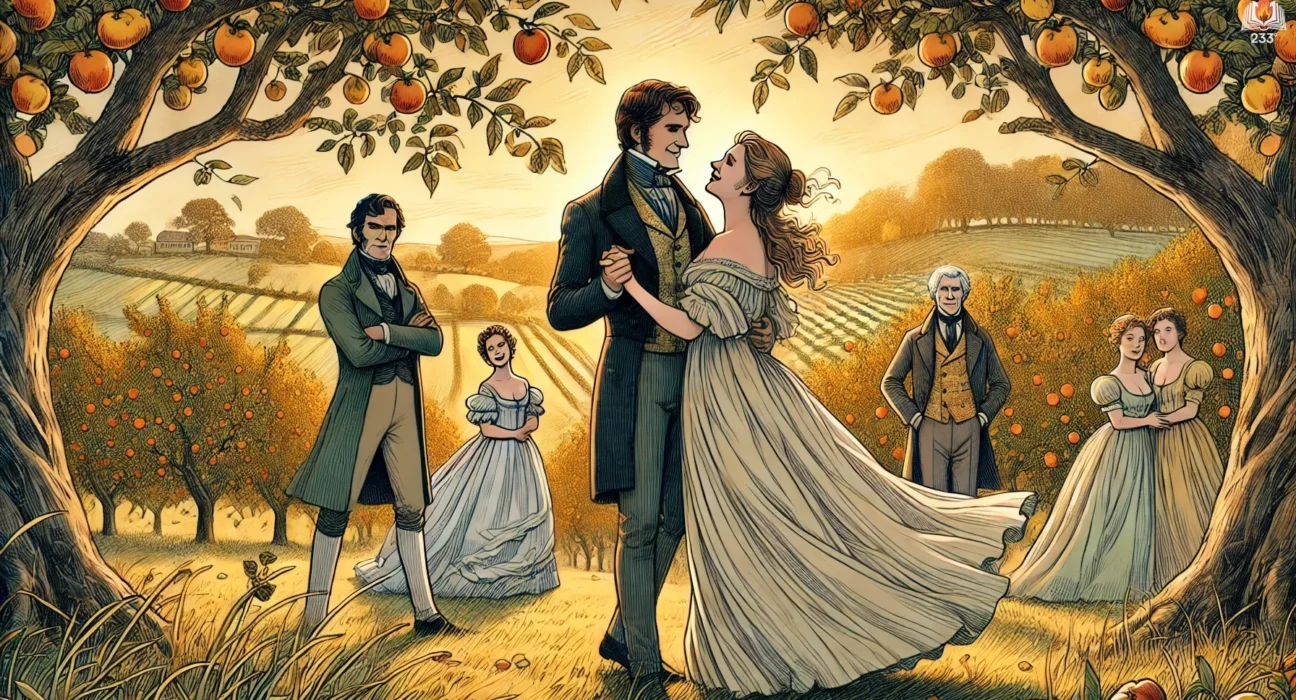“The Battle of Life” by Charles Dickens, published in 1846, is a unique tale in Dickens’ Christmas Books series, where the primary focus is on personal sacrifice, love, and the contrasts between cynical views of life and the innocence of idealistic love. Set in a quaint English countryside, the story unfolds around the lives of Doctor Jeddler and his two daughters, Marion and Grace, as they grapple with love, loyalty, and sacrifice. Unlike Dickens’ usual narratives, this novella does not feature supernatural elements, relying instead on the complex emotional lives of its characters.
Plot Summary
On a peaceful autumn morning in the quaint English countryside, Doctor Jeddler’s orchard brims with music and laughter. Amidst the apple trees, Marion and Grace, Doctor Jeddler’s two daughters, whirl and dance, their skirts floating around them as they share in the simple joys of life. Doctor Jeddler, a man with a stern philosophy that life itself is a grand farce, watches with mild amusement. To him, the world is absurd and unworthy of earnest emotions. But his daughters, especially Marion, who has caught the eye of Alfred Heathfield, embody a liveliness and warmth that challenge his beliefs.
Alfred Heathfield, Doctor Jeddler’s devoted ward, has long loved Marion. They grew up together, their youthful friendship evolving over time into a bond that seemed destined for marriage. With his studies now complete, Alfred is about to embark on a journey abroad to further his knowledge and build a future for them. On this last day before his departure, he brings musicians to the orchard as a birthday gift for Marion, knowing she cherishes small gestures of affection. Marion’s laughter echoes through the trees, yet beneath her gaiety, she is weighed by an inner turmoil. Grace, ever observant, senses her sister’s hesitation, though Marion speaks of Alfred with admiration and affection.
As Alfred prepares to say goodbye, Marion clings to Grace, her gaze lingering on her sister’s serene face. Grace assures him that Marion will be safe in her care, vowing to keep her happiness secure until he returns. Alfred departs with an optimistic heart, promising a brighter future to both sisters. Doctor Jeddler, too, finds comfort in the hope of Alfred’s return, though he teases Grace about the futility of young love, the sentiments so often fleeting.
Time passes, and in the quiet village life, Michael Warden enters, a man carrying a shadowed past. He is spirited, handsome, and somewhat reckless, and despite his charms, he is burdened by financial troubles and a reputation that speaks of frivolous pursuits. Though he once lived freely, Warden finds himself drawn to the quiet dignity of Doctor Jeddler’s household. When he meets Marion, his fascination deepens; her beauty, sincerity, and the quiet sorrow within her captivate him, stirring a sense of desire he cannot easily dismiss. Warden soon learns of Marion’s engagement to Alfred, but he grows convinced that Marion harbors doubts about her future.
Marion, torn between duty and a quiet yearning for something unnamed, finds herself ensnared in an unspoken bond with Warden. Grace senses this tension in Marion’s heart and observes how Marion subtly avoids Alfred’s name in conversation, sidestepping questions about their future with a hesitation that hints at a lingering uncertainty. Warden, ever perceptive, notices these hesitations and, emboldened, confesses his feelings to Marion, urging her to consider a different life by his side. Marion is struck by the intensity of his words, but she remains steadfast, knowing that a bond of loyalty to Alfred still binds her.
The household, oblivious to the depths of Marion’s inner conflict, carries on. Doctor Jeddler, with his humorous cynicism, mocks love and all its declarations, finding in Warden an amusing conversational partner. But Grace’s attentiveness grows sharper. She feels the weight of Marion’s unspoken emotions, and in a selfless act, decides that she must let Marion choose her own path, even if it means breaking a promise to Alfred. Late one night, after an intense struggle with her emotions, Marion vanishes, leaving a letter behind, in which she entrusts her sister with her last request: to protect Alfred from the heartbreak of her departure.
When the family discovers Marion’s absence, shock and sorrow fill the once lively household. Doctor Jeddler is astounded, his philosophy of life’s absurdity now shaken by the very real pain he feels over his daughter’s departure. Grace, heartbroken yet resolute, honors her sister’s wish, keeping the letter’s contents a secret and comforting her father in his grief. Alfred, upon hearing of Marion’s disappearance, is devastated. To him, Marion’s absence is a wound that does not heal, leaving him haunted by memories of their shared past and the unfulfilled promise of their future.
Years pass, and the village moves on, yet Marion’s memory lingers in every corner of Doctor Jeddler’s house. Grace remains steadfast, carrying her sister’s memory in silent reverence, while caring for her aging father, whose once dismissive views of life’s meaning grow softer with time. Marion’s absence leaves an unspoken sadness in Grace’s eyes, a quiet reminder of the sacrifice she made to keep her sister’s secrets and honor her wishes.
One day, years after Marion’s departure, the past returns to the village in the form of Alfred Heathfield, now a man transformed by the trials and wisdom gained from his travels. He arrives unexpectedly, his heart still carrying a scar from the love he lost. As he reconnects with Grace, he sees in her all the warmth and strength that had always been there, and he begins to find comfort in her companionship. Grace, though carrying her own silent grief, receives Alfred’s friendship with gentle acceptance, knowing that time and loss have woven their lives together in ways neither had expected.
As seasons turn and time heals old wounds, Alfred and Grace find themselves drawn to each other in ways they never anticipated. Slowly, they discover a new bond between them, one born of mutual understanding and the shared sorrow of having loved and lost Marion. Their affection grows, a quiet, enduring love that emerges from the ashes of the past, giving them a chance to build a life together. Grace, no longer bound by the secrets of the past, finds peace in Alfred’s presence, and they forge a future together, filled with a gentler, deeper kind of love.
In Doctor Jeddler’s home, love has indeed transformed lives, transcending cynicism and heartbreak. Though Marion’s absence remains a bittersweet memory, Grace and Alfred’s union brings solace, showing that love endures even through sacrifice. Doctor Jeddler, now older and softened by the years, watches his daughter and Alfred with a newfound respect for the love he once mocked. In the quiet of his heart, he comes to accept that life, far from being a mere farce, holds mysteries and wonders beyond his once-limited philosophy.
The peaceful orchard, once filled with youthful laughter, now witnesses a new serenity. Grace and Alfred walk together, hand in hand, their bond a tribute to the love they shared for Marion and the sacrifices that shaped them. The memory of Marion lingers in the gentle rustle of the orchard leaves, a silent testament to a life that touched many, even in absence. Together, Grace and Alfred face the future, grounded in the knowledge that true love, whether found in sacrifice or companionship, gives life a beauty and meaning far beyond the limits of understanding.
Main Characters
Doctor Jeddler: A philosopher with a cynical outlook on life, Jeddler believes life to be a farce and human emotions trivial. Despite his outlook, he is a loving father to Marion and Grace, who subtly challenge his philosophy through their actions.
Grace Jeddler: The older daughter of Doctor Jeddler, Grace is compassionate and steady, acting as a maternal figure after the death of her mother. Her relationship with her younger sister is affectionate, and her sacrifice for Marion underscores her selflessness.
Marion Jeddler: The younger daughter, Marion is beautiful and spirited, but her life takes a complicated turn when she finds herself the object of two men’s affections. Her character reflects innocence and the intensity of young love.
Alfred Heathfield: A devoted lover of Marion, Alfred is earnest and determined to make a future for himself and Marion. He represents the novel’s idealism, contrasting with Doctor Jeddler’s cynicism.
Michael Warden: A dashing but troubled man, Warden brings complexity to the romantic tension in the story as he becomes infatuated with Marion, leading to a series of misunderstandings and heartbreak.
Theme
Sacrifice: The core theme of the novella revolves around the sacrifices people make for those they love. Grace’s decision to forgo her own happiness for her sister’s sake exemplifies this, suggesting that love often demands profound selflessness.
Cynicism vs. Idealism: Doctor Jeddler’s philosophy that life is a “farce” clashes with the hopeful idealism of youth, embodied by his daughters. This contrast raises questions about the validity of viewing life as meaningless versus seeing it as full of purpose and emotion.
Family and Loyalty: The bond between Marion and Grace highlights the depth of sisterly love. Their commitment to each other showcases the strength of familial loyalty even over romantic attachments.
The Redemptive Power of Love: Characters like Alfred and Grace reveal how love can transform perspectives and bring redemption, providing a counterbalance to Doctor Jeddler’s cynicism.
Writing Style and Tone
Dickens’ style in “The Battle of Life” is richly descriptive, filled with vivid imagery that brings the idyllic English countryside to life. His opening passages often present a pastoral calm that is soon disrupted by emotional tension, creating a juxtaposition between setting and character struggles. Dickens uses an omniscient narrator to delve into the inner thoughts of his characters, particularly exploring Doctor Jeddler’s philosophy through his interactions with his daughters. This narrative choice allows Dickens to critique cynicism humorously while retaining empathy for his characters.
The tone of the novella is warm, occasionally veering into wistful and melancholic, especially in scenes depicting sacrifice and unspoken love. Dickens tempers Jeddler’s cynicism with the sincerity of Grace and Alfred, and his tone alternates between playful mockery of Jeddler’s philosophy and genuine empathy for the trials of his characters. The contrast creates a narrative that feels both light-hearted and earnest, underscoring the depth of human emotions despite Jeddler’s claim that life is a farce.
We hope this summary has sparked your interest and would appreciate you following Celsius 233 on social media:
There’s a treasure trove of other fascinating book summaries waiting for you. Check out our collection of stories that inspire, thrill, and provoke thought, just like this one by checking out the Book Shelf or the Library
Remember, while our summaries capture the essence, they can never replace the full experience of reading the book. If this summary intrigued you, consider diving into the complete story – buy the book and immerse yourself in the author’s original work.
If you want to request a book summary, click here.
When Saurabh is not working/watching football/reading books/traveling, you can reach him via Twitter/X, LinkedIn, or Threads
Restart reading!








